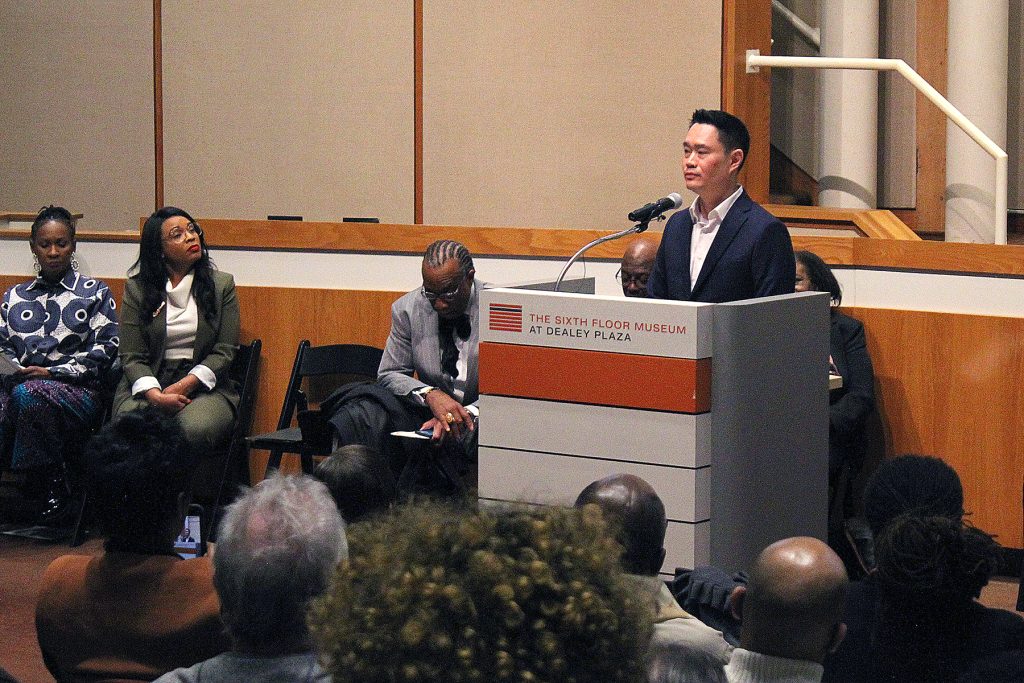By David Wilfong
NDG Contributing Writer
The City of Dallas took another step in the direction of acknowledging its past with the addition of a new public art piece officially dedicated this week.
A sculpture entitled “Shadow Lines” was recently installed in Martyrs Park, a special use park maintained by the Parks and Recreation department just west of Dealey Plaza in Dallas’ West End district. A collection of civic leaders and elected officials gathered in the Sixth Floor Museum on Tuesday morning for a dedication ceremony.
The dedication was planned to finish at the park but was kept indoors due to inclement weather.
The clearing where the park now stands was the site of a lynching of three Black men in 1860 who had been accused of starting a fire that burned down a significant portion of the city’s early downtown area. Though most today point to early phosphorus matches as the likely cause of the blaze, residents at the time saw it as evidence of a “Black uprising” and looked for culprits among the slave population.

Patrick Jennings, Cato and Rev. Samuel Smith were lynched on the site. The memorial installed and dedicated this week also names other Black residents who were similarly killed in the streets and parks in Dallas between 1853 and 1920.
The ceremony was led by Ed Gray of the Dallas County Justice Initiative, who had been instrumental in the push to have an art piece installed which was appropriate for the park’s historical past. Beverly Davis of Remembering Black Dallas – another key organization pushing to preserve the memory of African-American history in the city – also spoke at the dedication.
Representing local government were Dallas Councilmembers Tennell Atkins, Carolyn King Arnold and Jesse Moreno. Texas Senator Royce West and Dallas County Commissioner John Wiley Price also made remarks. They were joined by Parks and Recreation Director John Jenkins and Office of Equity and Inclusion Director Dr. Lindsey Wilson.
Part of the artwork is a poem written by Tim Seibles and inscribed into the metal wall which was read by Assistant City Manager, M. Elizabeth (Liz) Cedillo-Pereira. She noted that Siebles had been a teacher at her Alma Mater, North Dallas High School.
“To heal as a community, we must do the difficult work of confronting the city’s histories of racial injustice, while exploring how that history continues to shape the present,” Cedillo-Pereira said. “Leading projects that focus on racial healing as a part of the City’s Racial Equity Plan helps us move forward as a city, cultivating a more equitable future. We are grateful to our community partners for collaborating with us on Shadow Lines.”
Numerous dignitaries making remarks at the event recalled the memory of Dr. George Keaton, Jr., founder of Remembering Black Dallas and a staunch advocate for preserving the history of the city, especially in regards to its African American community. Keaton passed away in 2022.
Artist Normal Lee, co-designer of the Shadow Lines sculpture along with Shane Albritton (of RE:site Studio), credited Keaton for both the drive to memorialize the ground where the artwork stands, as well as the direction the artists took in its creation.

“We took our primary inspiration from the words of Dr. Keaton, that this memorial, in his words, would be a ‘reverent reminder’ that lynchings happened on the ground that we walk on every day,” Lee said in his remarks to the gathering. “Hence, the memorial evokes a sundial.
“Instead of marking hours of the day, it marks the date of each victim of racially-motivated violence and hangings; from the time of slavery to the Jim Crow era in Dallas. Where the longest shadow of these dates falls on the memorial wall is where the names are located, as if the shadow itself cut into the steel, indelibly etching the memory of each victim forever in the heart of the city.”




